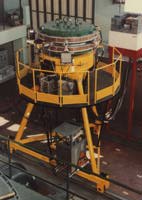
ADA was a ring having a radius smaller than one meter and reaching an energy of only 250 MeV, in which, according to an original idea of B. Touschek, an electron beam and an antielectron (positron) beam moved in opposite direction.
Around 1960, the LNF started up the development of a very new accelerator: a colliding-beams accelerator. All modern elementary particle storage ring, among which LEP, the most recent and largest one reach an energy of 100 GeV, derive from the first prototype in Frascati, ADA (Anello di Accumulazione).

ADA was a ring having a radius smaller than one meter and reaching an energy of only 250 MeV, in which, according to an original idea of B. Touschek, an electron beam and an antielectron (positron) beam moved in opposite direction.
Once ADA started up working in 1961, the creation of the ADONE ring began immediately after. ADONE produced an energy of 1.5 GeV, whith held the world record of energy for a period beginning from 1969. The early experiments on ADONE paved the way for a new era in the knowledge of stucture of the particles making up the atomic nuclei. Since then, after having been restructured and renewed, ADONE and it's injector LINAC have continued to be research instruments of primary importance in the field of nuclear and subnuclear physics and in structure of matter.
Today LNF have a new circular acceleretor of intersecting
rings of electrons and positrons, DAFNE,
that is situated in the ADONE building. DAFNE
has an energy inferior to one GeV but a very high luminosity, enough to allow
experiments, like KLOE and FINUDA
of elevated precision on fundamental ideas of particle physics. Furthermore,
the LNF design and produce other advanced accelerators, also superconducting.

|
F.M . | F.E. | L.S. |